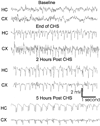Ketamine controls prolonged status epilepticus
- PMID: 11074184
- PMCID: PMC2885610
- DOI: 10.1016/s0920-1211(00)00175-3
Ketamine controls prolonged status epilepticus
Abstract
New treatments are needed to control prolonged status epilepticus given the high failure rate of current therapies. In an animal model of status epilepticus based on electrical stimulation of the hippocampus, rats demonstrate at least 5 five-hours of seizure activity following stimulation. Phenobarbital (70 mg/kg) administered 15 min after stimulation effectively controlled seizures in 66% of animals (n=6). When phenobarbital (70 mg/kg) was administered 60 min after stimulation, seizures were controlled in 25% of animals (n=4). Ketamine (100 mg/kg) administered 15 min after stimulation did not control seizures in any animal (n=4). But when ketamine was administered one hour after stimulation it effectively controlled seizures in all animals (n=4). Increasing doses of ketamine were administered 60 min after stimulation to generate a dose-response curve. The ketamine dose response (fraction of seizure free rats) data were fit to a sigmoid curve to derive an ED(50) of 58 mg/kg. These findings suggest that prolonged status epilepticus becomes refractory to phenobarbital but can be effectively controlled by ketamine. For patients experiencing prolonged status epilepticus that is refractory to phenobarbital, ketamine may be an alternative to general anesthesia.
Figures




References
-
- Bertram EH, Lothman EW. NMDA receptor antagonists and limbic status epilepticus: a comparison with standard anticonvulsants. Epilepsy Res. 1990;5:177–184. - PubMed
-
- Clifford DB, Olney JW, Benz AM, Fuller TA, Zorumski CF. Ketamine, phencyclidine, and MK-801 protect against kainic acid-induced seizure-related brain damage. Epilepsia. 1990;31:382–390. - PubMed
-
- DeGiorgio CM, Tomiyasu U, Gott PS, Treiman DM. Hippocampal pyramidal cell loss in human status epilepticus. Epilepsia. 1992;33:23–27. - PubMed
-
- DeLorenzo RJ, Pellock JM, Towne AR, Boggs JG. Epidemiology of status epilepticus. J. Clin. Neurophysiol. 1995;12:316–325. - PubMed
-
- Fariello RG, Golden GT, Smith GG, Reyes PF. Potentiation of kainic acid epileptogenicity and sparing from neuronal damage by an NMDA receptor antagonist. Epilepsy Res. 1989;3:206–213. - PubMed
Publication types
MeSH terms
Substances
Grants and funding
LinkOut - more resources
Full Text Sources

